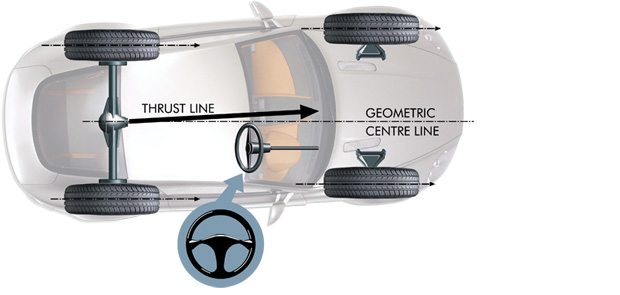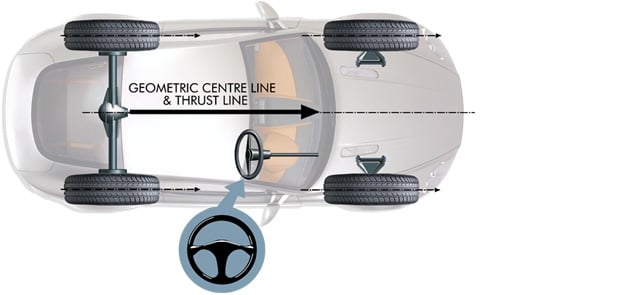
Does your car pull to one side? Are the tyres worn excessively, or unevenly? Does the steering wheel vibrate, and do you have to constantly keep steering your car to travel straight ahead? These are the symptoms that your car is out of alignment.
Many handling problems can be corrected by an alignment - with all the system components properly aligned, road shock is more efficiently absorbed for a much smoother ride.
CLICK HERE FOR PRICING
The Underwood Tyres Alignment System offers two kinds of alignment:
Front Wheel Thrust Alignment:
This method ensures that the front wheels are aligned to the centre line of the vehicle. However, because the front wheels are not referenced to the alignment of the rear wheels the steering wheel may be off centre.
For vehicles without any rear suspension adjustment, the front wheels are aligned to the thrust angle of the rear wheels, ensuring that the vehicle tracks straight and the steering wheel is centred.

Front & Rear Wheel Alignment:
For vehicles with adjustable rear suspension, all four wheels are aligned to the geometric centre of the vehicle, ensuring that the vehicle tracks straight ahead and the steering wheel is centred.

What is Wheel Alignment?
A wheel alignment or tyre alignment is a manual adjustment of a vehicle’s suspension system. During an alignment a tyre and auto professional will tweak different suspension components to restore them to their correct setting. Adjusting your car’s suspension system can improve overall handling, prevent issues with steering, and help your tyres last longer.
The three main parts that are checked and adjusted during an alignment are:
- Camber: The inward or outward tilt of your tyres when you look front on.
- Toe: The inward or outward angle when you view your tyres from above.
- Caster: The angle of your steering axis when viewed side on.
How do you know if your wheels need alignment?
The correct settings for wheel alignment are very precise so you’ll probably notice a difference in the feel and function of your car if you need an alignment. Look out for the following symptoms:
- The steering wheel is crooked when you are driving straight
- Unusual sounds when steering
- Your car pulls to either the left or ride when you drive
- Squealing tires
- Excessive / uneven tyre wear
How ofter should I get a wheel alignment?
- Wheel alignments are usually conducted as part of your regular scheduled
servicing. - But, you should also consider booking in for an alignment if you have:
- Recently replaced a part of your steering or suspension
- Driven over a large bump or experienced a sudden jolt when driving.
- Been involved in an accident that caused you to jerk your breaks.
Some symptoms of misalignment:
- squealing tyres
- unusual sounds when driving
- a pull to the side when steering
- Tyres wearing down quickly or unevenly
- Your steering wheel is not centred when you’re driving straight
How long does a wheel alignment last?
There is no set amount of time that a wheel alignment is guaranteed to last for.
This is because misalignment can happen from something as simple as hitting the kerb or driving over a pothole. For this reason, it is recommended that you have a wheel alignment twice a year or every 10,000km (whichever comes first).
And if you notice anything out of the ordinary with your steering or tyres, book in with a professional immediately for a check. They will be able to properly examine your car and advise whether a wheel alignment is necessary or not.
What happens when I drive with a bad wheel alignment?
Misaligned wheels can cause issues with fuel efficiency, increased tyre wear, and impact on safety and handling.
When tyres aren’t correctly aligned they tend to drag more which means the vehicle needs more fuel to get moving.
Misalignment also leads to rapid tyre wear and the need for early tyre replacement.
The most serious impact of bad wheel alignment is the impact on handling. It may seem trivial but could cause more serious safety issues if you need to make an emergency manoeuvre and your car doesn’t respond as it should.
Is it necessary to get an alignment with new tyres?
It is strongly recommended that you have a wheel alignment when you have new tyres put on your vehicle.
An alignment helps to extend the life of your tyres and keep you safe on the road by ensuring all tyres meet the road at the correct angle and are properly centred.
This means better fuel mileage, increased longevity of your tyres and better handling and response - essential for your safety, and the safety of others on the road.